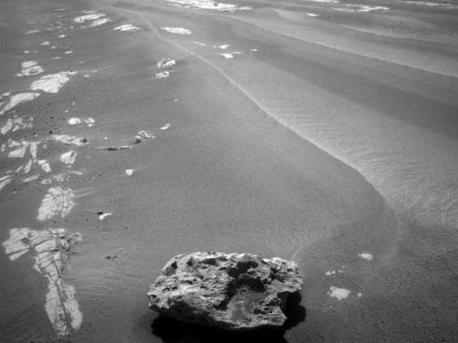Mars Rover
Opportunity discovers biggest Mars Meteorite
 © NASA/JPL-Caltech
|
This image of "Block Island" was taken on July 28, 2009, with the front hazard-identification camera on NASA's Mars Exploration Rover Opportunity.
Opportunity was on its way to a near crater when the scientists analyzed the pictures that were sent to them. They saw the suspiciously dark chunk and named it "Block Island". With a diameter of two feet and a height of about one foot "Block Island" is twice the size of former record holder, which was found close to the dropped heat shield of Opportunity.
Scientists tested the rock with the alpha particle X-ray spectrometer to get composition measurements and to confirm if it is a meteorite. The tests confirmed that the rock is indeed a meteorite out of iron. Close up pictures reveal that the rock is partly covered with a thin dust layer, but the metallic surface underneath still shines through. The scientists hope to gain knowledge about the climate history through further investigation.
The size of the rock alone hints to the fact that it fell on Mars when the atmosphere was much denser than today. Today's thin atmosphere would not be able to slow down the meteorite enough for it to exist as we see it on the pictures. The meteorite would have impacted with high velocity and melted completely. Now researchers want to look for rust on the surface of the "block Island", which could show if and when the meteorite came in contact with water.
Mars Rover
Opportunity discovers biggest Mars Meteorite
 © NASA/JPL-Caltech
|
This image of "Block Island" was taken on July 28, 2009, with the front hazard-identification camera on NASA's Mars Exploration Rover Opportunity.
Opportunity was on its way to a near crater when the scientists analyzed the pictures that were sent to them. They saw the suspiciously dark chunk and named it "Block Island". With a diameter of two feet and a height of about one foot "Block Island" is twice the size of former record holder, which was found close to the dropped heat shield of Opportunity.
Scientists tested the rock with the alpha particle X-ray spectrometer to get composition measurements and to confirm if it is a meteorite. The tests confirmed that the rock is indeed a meteorite out of iron. Close up pictures reveal that the rock is partly covered with a thin dust layer, but the metallic surface underneath still shines through. The scientists hope to gain knowledge about the climate history through further investigation.
The size of the rock alone hints to the fact that it fell on Mars when the atmosphere was much denser than today. Today's thin atmosphere would not be able to slow down the meteorite enough for it to exist as we see it on the pictures. The meteorite would have impacted with high velocity and melted completely. Now researchers want to look for rust on the surface of the "block Island", which could show if and when the meteorite came in contact with water.






